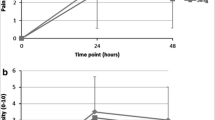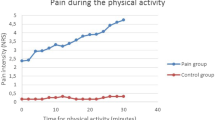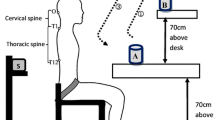Abstract
The purpose of this study was to assess the perception of muscle tension in chronic pain patients and healthy controls. Twenty chronic back pain patients, 20 patients who suffered from temporomandibular pain and dysfunction, and 20 healthy controls were instructed to produce eight different levels of muscle contraction in either the m. masseter or the m. erector spinae. Each level was produced three times; trials were presented in random order. Analyses of the accuracy and the sensitivity of discrimination of muscle tension levels revealed that the patients were less able to perceive muscle contraction levels correctly and that they underestimated their actual levels of muscle tension. Patients and controls did not differ in the extent to which they contracted muscles not involved in the task. Patients suffering from musculoskeletal disorders seem to display a genuine deficit in discrimination of muscle tension that is related to neither local physiological changes at the site of pain, lack of motivation, inattention, nor fatigue.
Similar content being viewed by others
References
Applebaum, K. A., Blanchard, E. B., & Andrasik, F. (1989). Muscle discrimination ability at three muscle sites in three headache groups.Biofeedback and Self-Regulation.
Birbaumer, N. (1975).Physiologische Psychologie [Physiological Psychology]. Berlin: Springer.
Birbaumer, N., & Schmidt, R. F. (1990).Biologische Psychologie [Biological Psychology]. Berlin: Springer.
Bischoff, C. (1989).Wahrnehmung der Muskelspannung [Perception of muscle tension]. Göttingen: Hogrefe.
Bischoff, C., & Wilker, F.-W. (1979). Wahrnehmung von Muskelspannung bei Personen mit Spannungskopfschmerz [Tension perception in patients with tension headache]. In L. H. Eckensberger (Ed.),Bericht über den 31. Kongress der DGfPs in Mannheim 1978, Bd. 2 [Proceedings of the 31st Convention of the German Psychological Association in Mannheim 1978, Vol. 2] (pp. 175–177). Göttingen: Hogrefe.
Blanchard, E. B., Jurish, S. E., Andrasik, F., & Epstein, L. H. (1981). The relationship between muscle discrimination ability and response to relaxation training in three kinds of headache.Biofeedback and Self-Regulation, 6 537–545.
Carroll, D. (1977). Cardiac perception and cardiac control.Biofeedback and Self-Regulation, 2 349–369.
Dahlström, L., Carlsson, S. G., Gale, E. N., & Jansson, T. G. (1985). Stress-induced activity in mandibular dysfunction: Effects of biofeedback training.Journal of Behavioral Medicine, 8 191–199.
Dickson-Parnell, B., & Zeichner, A. (1988). The premenstrual syndrome: Psychophysiologic concomitants of perceived stress and low back pain.Pain, 34 161–170.
Epstein, L. (1990). Perception of activity in the zygomaticus major and corrugator supercilii muscle regions.Psychophysiology, 27 68–72.
Flor, H. (1991).Psychobiologie des Schmerzes [Psychobiology of pain]. Bern: Huber.
Flor, H., & Birbaumer, N. (1991). Comprehensive assessment and treatment of chronic back pain patients without physical disabilities. In M. Bond (Ed.),Proceedings of the VIth World Congress on Pain (pp. 229–234). Amsterdam: Elsevier.
Flor, H., Birbaumer, N., Schugens, M. M., & Lutzenberger, W. (in press). Symptom-specific psychophysiological responses in chronic pain patients.Psychophysiology.
Flor, H., Birbaumer, N., & Turk, D. C. (1990). The psychobiology of chronic pain.Advances in Behavior Research and Therapy, 12 47–87.
Flor, H., & Turk, D. C. (1989). Psychophysiology of chronic pain: Do chronic pain patients exhibit symptom-specific psychophysiological responses?Psychological Bulletin, 105 215–259.
Flor, H., Turk, D. C., & Birbaumer, N. (1985). Assessment of stress related psychophysiological reactions in chronic back pain patients.Journal of Consulting and Clinical Psychology, 53 354–364.
Fowler, R. S., & Kraft, G. H. (1974). Tension perception in patients having pain associated with chronic muscle tension.Archives of Physical Medicine and Rehabilitation, 55 28–30.
Friedlund, A. J., & Cacioppo, J. T. (1986). Guidelines for human electromyography research.Psychophysiology, 23 567–589.
Kelso, J. A. S., (1977). Motor control mechanisms underlying human movement production.Journal of Experimental Psychology: Human Perception and Performance, 3 529–543.
Kravitz, E. A., Moore, M. E., & Glaros, A. (1981). Paralumbar muscle activity in chronic low back pain.Archives of Physical Medicine and Rehabilitation, 62 172–176.
McCloskey, D. I. (1978). Kinesthetic sensibility.Physiological Reviews, 58 763–820.
Schmidt, A. J. M. (1987). The behavioral management of pain: A criticism of a response,Pain, 30 285–292.
Stevens, S. S. (1961). To honor Fechner and repeal his law.Science, 133 80–86.
Stilson, D. W., Matus, J., & Ball, G. S. (1980). Relaxation and subjective estimates of muscle tension: Implications for a central effort theory of muscle control.Biofeedback and Self-Regulation, 5 19–36.
Waters, W. F., Williamson, D. A., Berard, B., Bryan, A., Blouin, D. C., & Faulstich, M. E. (1987). Test-retest reliability of psychophysiological assessment.Behaviour Research and Therapy, 25 213–221.
Whitehead, W. E., & Drescher, V. M. (1980). Perception of gastric contractions and self-control of gastric motility.Psychophysiology, 17 552–558.
Author information
Authors and Affiliations
Additional information
This research was supported by a grant from the Deutsche Forschungsgemeinschaft (FI 156/1 and FI 156/2) to the first author and a grant from the German Department of Science and Technology (FKZ 0701503) to the third author. The authors are solely responsible for the contents of this publication. The authors would like to thank Barbara Streit, Dr. Karl Schweizer, and Dr. Sybille Rockstroh for assistance in data collection.
Rights and permissions
About this article
Cite this article
Flor, H., Schugens, M.M. & Birbaumer, N. Discrimination of muscle tension in chronic pain patients and healthy controls. Biofeedback and Self-Regulation 17, 165–177 (1992). https://doi.org/10.1007/BF01000401
Issue Date:
DOI: https://doi.org/10.1007/BF01000401




